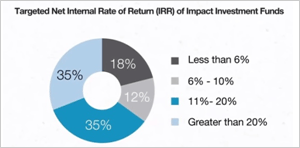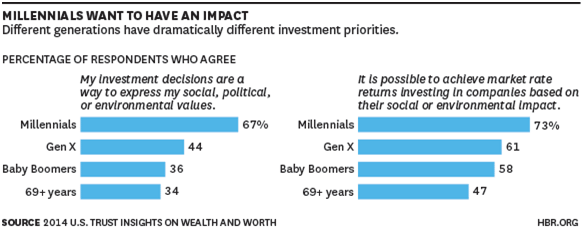Impact Investing 101

Investing for good - as well as profit
Marked the “Year of Impact Investing,” 2013 saw a total of $36 billion committed in capital for impact investing. By 2020, it’s estimated that figure will increase to $1 trillion. Hailed as the “future of capitalism,” impact investing leverages the speed of capital markets and the private sector in concert with the public sector and communities’ goals. The World Economic Forum has defined impact investing as an intentional strategy to create financial and social returns that are actively measured.
The growth of impact investing stems from investors wanting to not only create profit and financial returns but also to do good in the world. "As we've seen through the economic and financial crisis, money without values can maybe not create the world that we want," says Wayne Silby from Calvert Social Funds.
Challenges of impact investing
Some argue that the sector has been slow to scale since the term was coined in 2007 because of the plethora of definitions – there is a huge range of what people consider "impact." Sixty-six percent of financial advisors claimed to not understand impact investing, according to a 2013 CFA Institute survey. Certain skepticism also exists because it’s still less clear for investors how this type of investing can be integrated into portfolios.
The biggest obstacle the sector has run into is that it is difficult to predict what an investor’s return will be over time. This is the same as calculating the intrinsic value in the value-investing approach that mainstream investing has used for over 100 years, but impact investing does not have the rigorous prediction model that mainstream investing uses.
Regardless, impact investing has attracted significant public and media attention, and the investors in the space are the pioneers who are building impact investing capabilities and testing what works. As they have success, the next wave of impact investors will enter the market.
Does impact investing yield lower returns?
 Impact investing does not always require an investor to sacrifice financial returns for society’s benefit. “Impact investors have the ability to execute a variety of strategies that conform to their existing allocation needs but also produce impact,” said Pradeep Ramamurthy from The Abraaj Group. For reference, see the chart from the World Economic Forum showing the average rate of returns (IRR) of impact invest funds.
Impact investing does not always require an investor to sacrifice financial returns for society’s benefit. “Impact investors have the ability to execute a variety of strategies that conform to their existing allocation needs but also produce impact,” said Pradeep Ramamurthy from The Abraaj Group. For reference, see the chart from the World Economic Forum showing the average rate of returns (IRR) of impact invest funds.
Sonen Capital published a report highlighting the results of the seven-year impact investment portfolio it designed for the KL Felicitas Foundation. The results suggest that socially responsible investing and enviro-social factors can:
- Capture enhanced return by exploiting market inefficiencies
- Allow thematic investments to capitalize on long-term social or environmental trends
- Allow “impact first” investments to reduce overall portfolio volatility by giving a significant allocation to less-correlated investments.
More studies like these are necessary to demonstrate the business case for impact investing and the strategies to maximize returns for investors.
The future of impact investing
Millennials are almost twice as likely as their grandparents to regard their investments as a way to express social, political, or environmental values, and nearly three-quarters of millennials believe that it is possible to realize market-rate returns investing in companies based on their social or environmental impact.

In an interview, Michael Drexler from the World Economic Forum said, “We believe the interest of [millennials] will influence the actions of institutional investors, and impact investing will be part of that portfolio.”
That might be the case because over the next four decades, the baby boomer generation is going to transfer $41 trillion of assets to the millennial generation. Investors are going to have to think a lot more about businesses that do create a positive societal, environmental, and economic impact.
What we’ve seen and can predict is that global pressures on the environment and millennials’ interest to better align capital markets with social consciousness will expand the impact investing sector significantly in the next decade.
You can learn more about impact investing from any of these sources:
- Video: Impact Investing: Investing for Social Change
- TriLinic Global: Impact Investing Glossary of Terms
- Case Foundation: A Short Guide to Impact Investing
- Forbes: 5 Key Trends in Impact Investing




